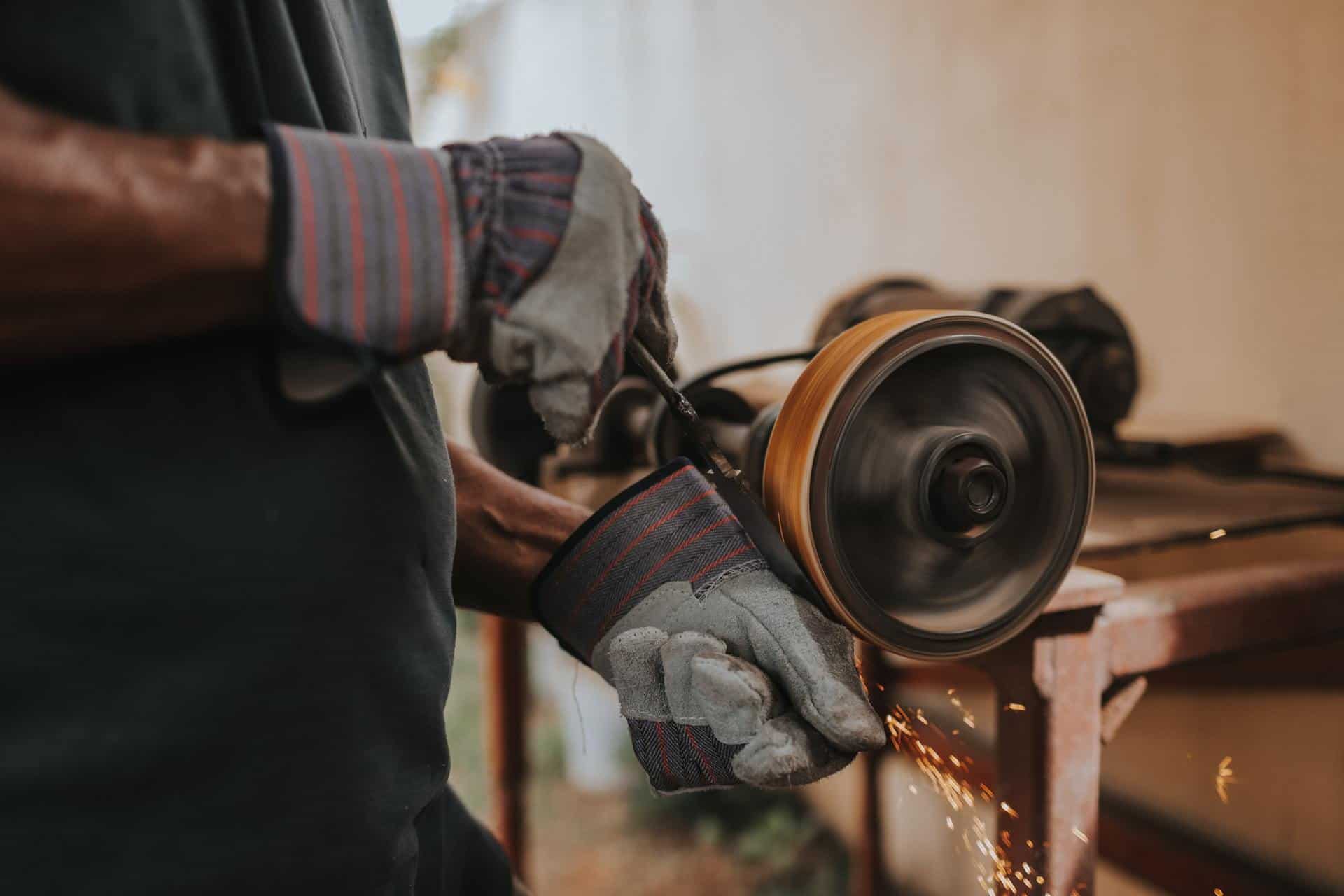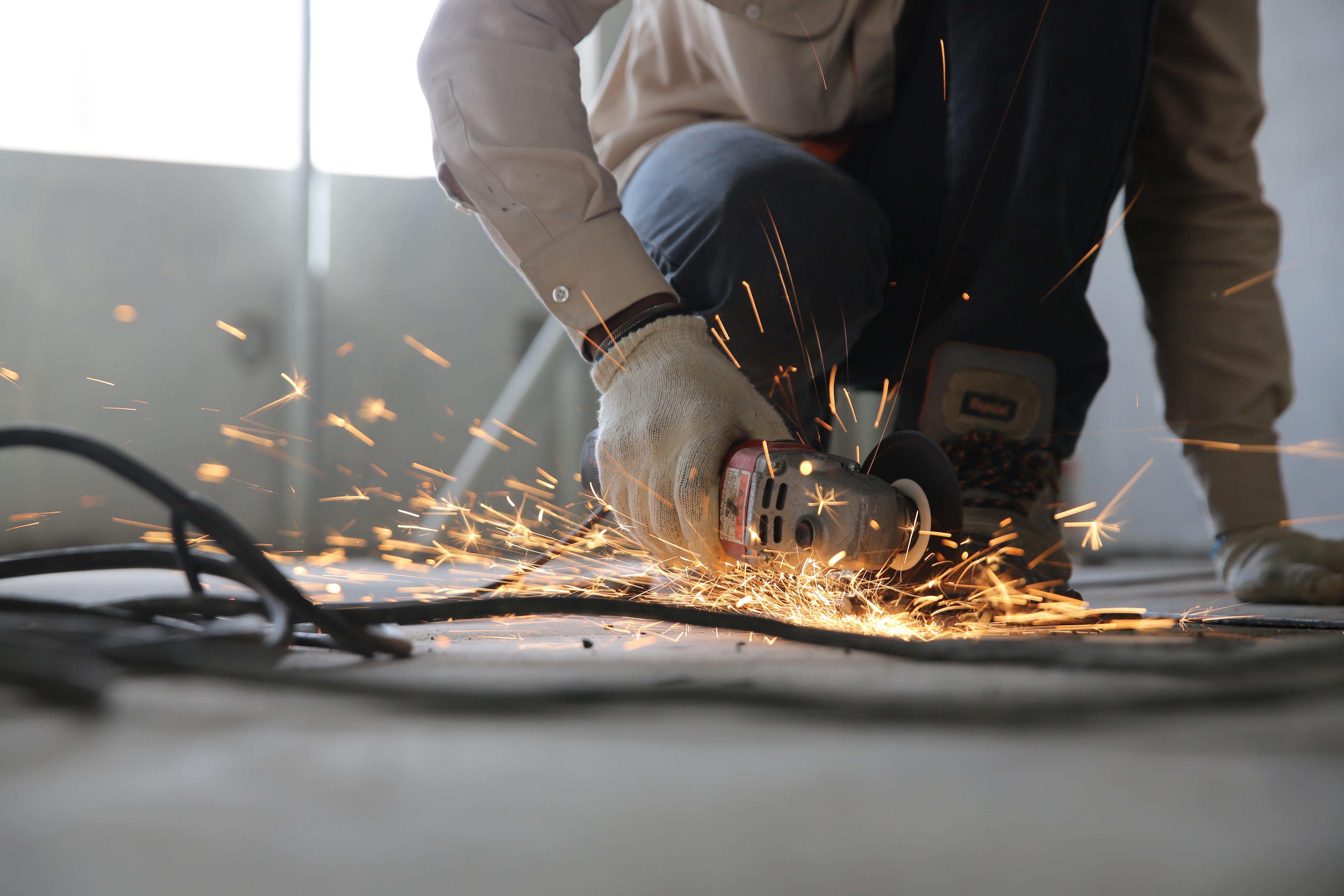
Have you ever wondered what the difference is between grinding and sanding? Are you struggling whether you will need a grinder or a sander for your project? In fact, these questions are frequently discussed among handymen and DIYers. In this post, we will finally shed a light on the differences and similarities of grinding and sanding as well as grinders and sanders. Be aware though that the lines between them are a bit blurred, on the definition as well as on the application side.
Working with grinders implies a more aggressive working on material that includes cutting and precision finishing of surfaces. These tools are used for all kinds of material and – with the right equipment – can even be used with the hard ones, e. g. metal, concrete, stone, etc.
Using a sander, on the other hand, is a finer way of material processing and usually helps achieving a smooth surface. Sanders are often used on softer materials like wood; however, you can also sand concrete surfaces or sharpen knives with a sander.
This is a high-level comparison of sanding and grinding with a focus on hand-held and DIY tools like angle or belt grinders and belt, disk and orbital sanders. We will be discussing the details in the following sections.
What Is a Grinder?
A grinder is a power tool that is used for grinding (obviously), cutting, sanding, brushing and other DIY areas.
Grinders come in different sizes and forms with application areas ranging from DIY to industrial use. For DIYers and semi-professional users, these are the two most common types:
- Belt grinders and
- Angle grinders (aka side grinders).
What Is an Angle Grinder?
An angle grinder is a tool with a geared head on the side on which you can mount abrasive or cutting discs but also brushes and other attachments.
Angle grinders are rather inexpensive and offer good value if you take their versatility into account.
Read more in our post “How to use an angle grinder”.
Check prices of angle grinders on Amazon.
What Is a Belt Grinder?
These grinders are often used as stationary rather than hand-held tools. They have an abrasive belt and some offer the option of attaching a contact wheel.
Belt grinders are (semi-)professional machines and will set you back at least a few hundred dollars.
Check prices of belt grinders on Amazon.
What Is a Grinder Used For?
Typical areas, for which you can consider using a grinder, are:
- Cutting,
- Rough shaping,
- Fine shaping,
- Sanding and smoothening the surface (if you use proper sand paper / discs), and
- Brushing and polishing (if your equipment allows it).
You can use most grinders for materials like:
- Wood,
- Plastic,
- Metal,
- Stone, and
- Concrete (will require a specific concrete grinder though).
What Is a Sander?
Sanders are used to sand, smooth and polish surfaces. As the name implies, these tools are using sandpaper as an abrasive.
Among the most common hand-held sanders are:
- Belt sanders,
- Disc sanders, and
- Orbital and random orbital sanders.
What Is a Belt Sander?
These sanders have a sandpaper belt and they are mostly used for rough or smooth sanding of large surfaces, e.g. for sanding wooden floors or slats.
Belt sanders come either as stationary or as hand-held tools, depending on their area of application.
Read more in our review of belt sanders.
Check prices of belt sanders on Amazon.
What Is a Disk Sander?
A disk sander is usually a stationary machine. For these types of sanders, the sandpaper comes in the form of a disk instead of a belt.
Check prices of disk sanders on Amazon.
What Is an Orbital Sander?
This power tool has a round pad and performs the sanding in circles, thus achieving smoother results compared to a belt sander. While an orbital sander creates a circular movement of the sandpaper, a random orbital sander adds an additional back-and-forth movement.
Read more in our review of random orbital sanders and learn the difference between orbital and palm sanders.
Check prices of orbital and random orbital sanders on Amazon.
What Is a Sander Used for?
Sanders are often used for:
- Fine shaping,
- Sanding and smoothening the surface, and
- Polishing.
You can use almost all sanders for work on material like:
- Wood, which is probably the most common area of application, and
- Plastic.
More robust and specialized sanders also allow you to work with:
- Metal,
- Stone, and
- Concrete.
What Is the Difference between a Sander and a Grinder?
Hand-held Grinders usually run faster than hand-held sanders and allow to choose from different speed levels (“variable speed”). You can also adjust the belt of belt grinders or buy additional equipment like brushes, metal cut off wheels or discs for sanding. With the latter, you can use your grinder as a sander while, on the other hand, you would not be able to use a sander for cutting metal, for instance.
Most sanders are not as powerful as grinders. In the past, sanders used to run at a fixed speed and did not offer many upgrading options but this has changed in recent years and nowadays you will also find variable-speed sanders and various attachments in the market.
Overview: Types of Grinders and Sanders and How They Are Typically Used
Grinder |
Sander | |
Common types |
|
|
Areas of application |
|
|
Materials |
|
|
Read more |
Angle Grinders vs. Orbital Sanders
As you can see, the difference between sanders and grinders are small. Some tool manufacturers even sell identical hand-held power tools under both names and label them as “grinder/sander”. While this holds true for angle grinders and orbital sanders (but not for random orbital sanders), differences are more obvious for their “siblings” with a belt.
Belt Grinders vs. Belt Sanders
Belt grinders tend to be more common in the form of a stationary machine for (semi-)professional use, particularly for processing hard materials, e.g. for work on metal or grinding knives.
Belt sanders, on the other hand, are common for woodworking – be it as a stationary machine or as a mobile tool, e.g. for sanding floors or countertops.
When to Use a Grinder?
A grinder is probably the first choice for the cutting of materials, e. g. concrete slabs or chunks of wood. If you already have a belt grinder, you can use it for both rough and fine shaping of objects like wooden furniture or stone. If you have the right equipment – i. e. sandpaper or discs with the suitable grit – you will be able to sand and smoothen a surface or even polish it.

Given the differences in speed and power (we have covered this already), a grinder is usually able to cope with a harder material than a sander.
What Are the Advantages of a Grinder?
A grinder is more versatile and often more powerful than a sander. Even if you use it for sanding, you can mount larger discs and therefore finish the job much faster for the same surface.
Some grinders come with a switch-angle function (angle grinders) or a slack belt (belt grinders) which allows you to work on surfaces that are more complex, so you can go beyond flat and even workpieces.
With the right attachments, you can also brush or cut metal or glass with your grinder.
When to Use a Sander?
Sanding is used for fine shaping of softer materials as well as smoothening or even polishing a surface. It allows you to use very fine sandpaper – the higher the grit number the finer the abrasion – and thus achieve shiny surfaces. Sanding is therefore the method of choice when it comes to wood (re-)finishing or restoration works.
However, there are several areas where you could use either tool, e. g. using a grinder with fine sandpaper as a sander or smoothening concrete surfaces where both grinding and sanding are possible.
What Are the Advantages of a Sander?
Belt sanders are ideal for the sanding of large wooden surfaces, e. g. before refinishing a hardwood floor. While orbital sanders and angle grinders have a similar functionality, random orbital sanders are equipped with the small but important difference in the way it moves the sandpaper. For super-smooth sanding, a random orbital sander is therefore second to none.
Is It Possible to Sand With a Grinder Or Grind With a Sander?
An angle grinder can be turned into a sander by using a sanding disk. You will not need an additional orbital sander if you already have an angle grinder. However, an angle grinder could not fully replace a random orbital sander: This power tool is unique because of its multidirectional movements and the smoother sanding results.
Belt grinders and belt sanders work in a similar way, so if you buy sandpaper belts for your grinder, you could actually turn it into a sander. However, when it comes to sanding a floor you will probably need a belt sander though, given that belt grinders are usually stationary tools.
The Conclusion: Which One Should You Buy – a Grinder or a Sander?
It depends on what you are up to: if you need a hand-held power tool that is versatile and offers both cutting and sanding functionality, consider going for an angle grinder (some call it “grinder/sander” as the functionality is largely overlapping).
However, if you do a lot of surface smoothening or woodworking, you might want to get a random orbital sander as well.
For belt sanders and belt grinders, the differences are more obvious: Belt sanders are ideal for woodworking and they are often mobile, so you could use them for floors or countertops. Belt grinders are often stationary and used for other, harder material than sanders.
Whichever power tool you decide to buy, make sure it meets the needs of your current and potential future projects and allows you to mount attachments and additional equipment.
Check out sanders and grinders on Amazon.





